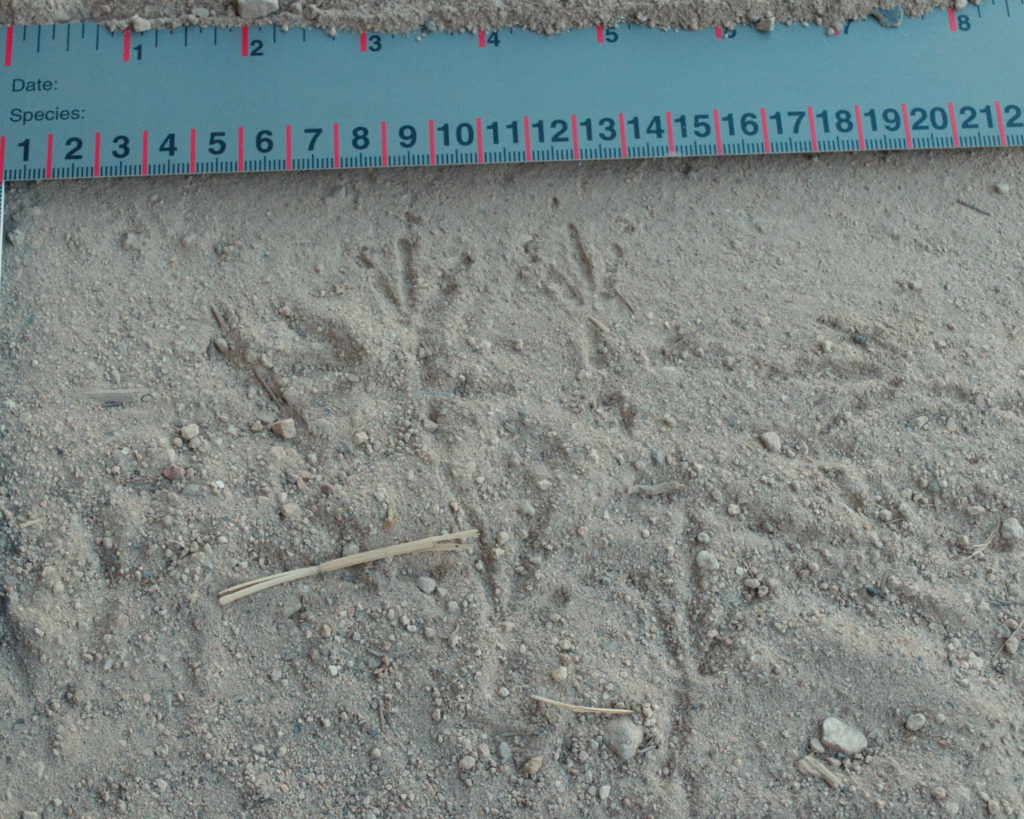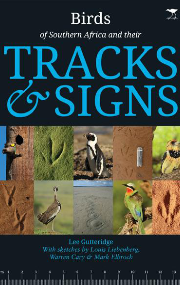Mike Watling (foxtracker805) sent this photo from the Channel Islands National Park, where he volunteers as a naturalist. He says, “The bird track is a spotted towhee. They will hang out in the bushes near my campsite (on Santa Rosa Island) and are frequently on the ground under the picnic table. For the spotted towhee, and birds in general, size and category (classic, game bird, etc.) is where I start, followed by gait (walk, hop). The spotted towhee track is similar to other sparrows and can be easily confused with other towhees. Locally, we have the CA towhee and spotted towhee. The CA towhee is larger (“two for towhee” is how we remember it, meaning 2 inches in length) while the spotted towhee in the 1.5 to 1.75 in range. Also, spotted towhee tends to hop while the CA towhee walks. Birds are tough since they migrate. It’s like a constant lineup change as birds migrate in and out…. birds are my weakness.”

Bird tracks and signs are a weakness for most trackers, until they really dive in and start learning them. Mark Elbroch and Eleanor Marks have an excellent book on Bird tracks for North America, pictured below.

To use the book, first you look at what kind of foot structure the bird has. Is it a classic bird track, like a child draws a picture with three toes forward and one toe straight back? Or, is it a game bird, with three long toes forward and a short toe (a dot or dash) pointing back at an angle? Or, is, it webbed (also called palmate) like a duck? Sometimes, you don’t see obvious webbing between the three forward toes in the track because of the substrate, but you can see the toes are pulled in, arcing towards each other, which indicates that they are being held by webbing. Then, totipalmate tracks have webbing between all four toes, which pulls them all together in a webbed “K” shape. There are only a few totipalmate birds, like pelicans and cormorants, to worry about. Finally, zygodactyl foot structure in birds is also four toes in a “K” shape, but without webbing. An example of this is an owl.
Once you determine the bird’s foot structure, you measure its track, and then flip to just inside the front cover for classic bird tracks, or just inside the back cover for the other types of bird tracks. Scan down the table of contents until you see the measurement you just recorded, in this case, the track measures between 1 5/8 and 1 7/8 inch (or 4.1 – 4.7 cm) for spotted towhee. There might be a few birds listed in that size range (green-tailed towhee, and Canyon towhee), so check them all by flipping to the pages listed and comparing your bird’s tracks to the information listed. Not all birds are in the book, either, but that gives us something to anticipate – the next volume! Then, as Mike, said, above, the behavior of the bird can be an important distinguishing feature – does it walk, or hop? Is it found near water, or in fields? Is it even in your range, remembering that birds migrate, too?
Featured item from the Tracker Mentoring Shop:
Lee Gutteridge has recently published (Feb., 2020) a first for Southern Africa, a book called, “Birds of Southern Africa and their Tracks & Signs.” It features the tracks and signs of over 200 Southern African species, and is loosely modeled after Mark and Eleanor’s book. In fact, Mark contributed some drawings on those migratory species that also occur in Southern Africa.
You can find a link to Lee’s book in our shop – it will take you out of our shop – directly to the publisher’s suppliers. Both an eBook and a printed version are available.

Other articles you may find interesting
- Introducing Tracker Mentoring! (And, introducing the tracks of the Crested Barbet!)
- Burchell’s Sandgrouse Tracks – Okavango Delta, Botswana
- Green Pigeon Scat, South Africa